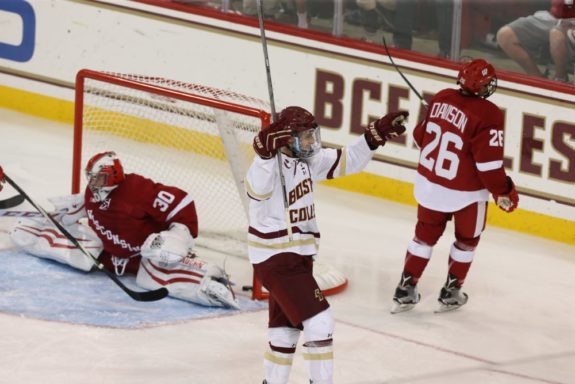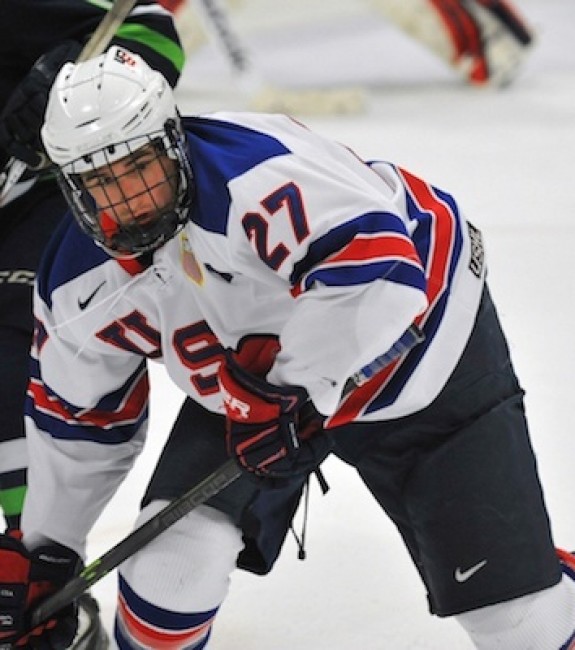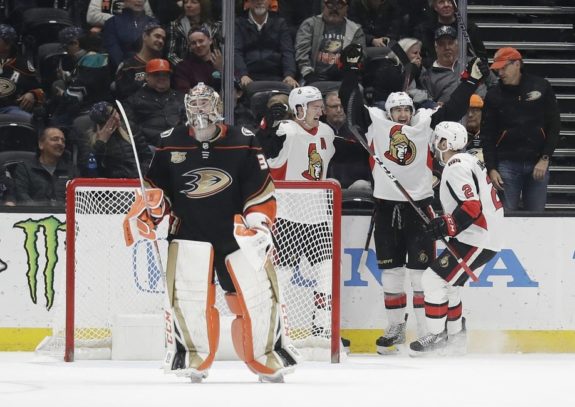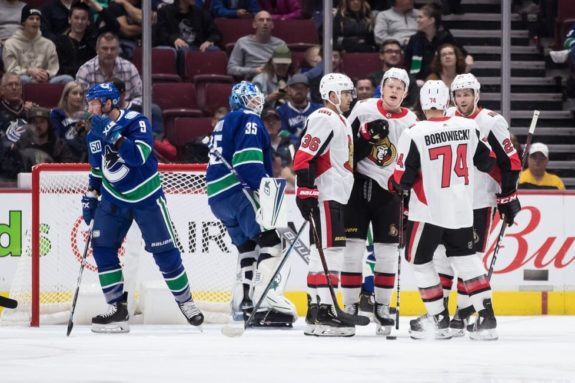Colin White’s time with the Ottawa Senators has been interesting, to say the least. Let’s take a look at the White years.
The Beginning
White was selected 21st overall in the 2015 NHL Draft. There was nothing strange about him being chosen in that range, but unfortunately, Ottawa 67’s star Travis Konecny was still available, leaving many fans disappointed with the pick. White went on to two solid, at times fantastic, seasons at Boston College where he scored 35 goals and 76 points in 72 games. He added 10 goals and 15 points in 14 World Junior Championship games.

When he signed with the Senators at the end of the 2017 season, many wanted him to be included on the playoff roster. That wish was granted in Game 6 of the Eastern Conference Final. In the big win, White played a grand total of 2 minutes and 39 seconds. All right, so head coach Guy Boucher didn’t trust him (he even turned to Chris Kelly instead for Game 7), but still, the White hype was growing.
The Scouting Report
It’s important to note what was expected of White. He was not considered the next big offensive star. He was a hard-working, two-way centre who was supposed to be annoying to play against, all while having enough offensive talent to contribute offensively as well. Looking back at his draft profile, a lot of the scouts made positive comments about his work ethic, defensive play, willingness to battle, as well as being disciplined and responsible.

While Sens fans likely wince at that scouting report which looks a lot like Curtis Lazar’s, the hope was for White to be a poor man’s Patrice Bergeron, or perhaps a rich man’s Brandon Sutter. Despite the hype, he was not seen as the next Jason Spezza by any means.
The First Pro Season
Heading into the 2017-18 season, there was hope that White could make the NHL out of camp. Unfortunately, an injury got in the way:
Upon his return, he headed to the AHL and a bad Belleville team. White also started from behind because of his wrist injury. These were legitimate excuses for a subpar season, but there were still reasons to be concerned. Here’s White’s season compared to 2015 2nd round pick, Filip Chlapik’s:
| Player | AHL games | AHL points | NHL games | NHL points |
| White | 47 | 27 | 21 | 6 |
| Chlapik | 52 | 32 | 20 | 4 |
It’s not as if Chlapik was a no-name prospect, but expectations for White were certainly much higher.
The Breakout Season
There was some debate at the start of 2018-19 if White had earned his roster spot or was handed it, but he did exactly what he needed to do early on to prove his worth: he scored a goal and added an assist in the first game of the season. In his first 25 games, he scored 16 points, showing that he belonged in the NHL. The concern, though, was that most viewed White as the third-best player on his line with Mark Stone and Brady Tkachuk.

Stone’s last game with the Sens was Feb. 18. To that point, White had scored 13 goals and 32 points in 53 games (0.25 goals per game, 0.6 points per game). After Stone left, despite an increase in ice time from 15:47 per game to 17:26, White scored just 1 goal and 9 points in 18 games (0.06 goals per game, 0.5 points per game). Tkachuk, by comparison, went from 0.63 points per game with Stone to 0.65 without. Nonetheless, a rookie season that produced 41 points in 71 games was a step in the right direction.
The Contract
Last summer, the Senators locked up White long term:
There was some relief that the Senators had signed a player to a long term contract after the team had traded so many players away. Having said that, there were obvious risks to this deal. White had one good season under his belt when he was a support player on his line.
The Sophomore Slump
In October, White was given close to 18 minutes of ice time per game. Over the next three months, his ice time dropped to just under 16 minutes per game, then under 14 minutes in February, before a jump back up for the five games in March to over 17 minutes per game (after JG Pageau was traded). The decrease was justifiable. White produced just 7 goals and 23 points in 61 games last season. His early-season injury played a factor, but at this point, his injury history is something worth monitoring.

White was also not the defensively strong, two-way player fans were expecting. He did not kill penalties, won less than 48% of his faceoffs, and ranked just 8th on the team in takeaways. He was also given offensive zone starts close to 57% of the time, and his Corsi For Percentage (CF%, which takes into account shots + blocks + misses for and against at even strength) was under 50% which means the opposition controlled the puck more than the Sens when White was on the ice. To be fair, most Senators had a poor CF% as the team was simply not very good.
The Look Ahead
One question I have about White: what is his defining quality? He’s okay at most things, but not great at anything. He’ll never be Patrice Bergeron, but in order for him to reach even close to that level, he has to become much stronger. His willingness to go to the dirty areas is there, but his ability to stay on his feet and to win those battles is lacking.
Related: A Brief History of NHL Uniforms
Adding strength to his game will make his compete level stand out more. He’ll need to stay healthy, but perhaps a stronger White will lead to a more confident White, which will lead to more of this:
The Bottom Line
I’ve been hard on him, but as the Senators’ second-highest-paid forward, and signed to a long-term deal where he’s expected to be part of the young core moving forward, I believe the criticism is justified. One poor season will not define him, but with Joshua Norris, Shane Pinto and potentially a big-time centre prospect being selected in the top-five of this year’s draft, competition for ice time is coming White’s way. Hopefully, a healthy, stronger White shows up next season and proves his worth.